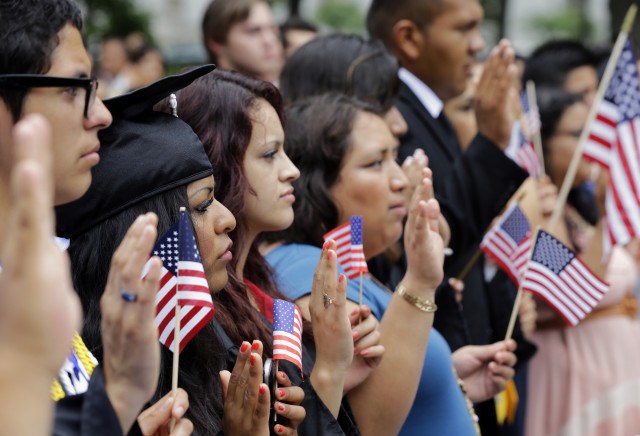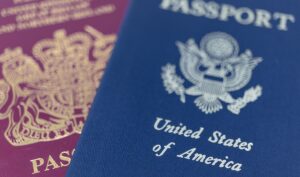
Once you become a U.S. citizen, you have access to additional benefits and services. But there are still some actions you’ll need to take in order to take advantage of your new status. Sure, you can wait until you need them. But often these benefits and services take time to obtain. It’s smart to take care of them immediately after becoming a U.S. citizen, before you forget or lose important paperwork.
Key Actions for New U.S. Citizens
- Apply for a U.S. Passport
- Update Social Security Records
- Apply for a Certificate of Citizenship for Children
- Register to Vote After Becoming a U.S. Citizen
- Update Your Citizenship Status with Employers
- Update Your Citizenship Status with Financial Institutions
- Update Your Estate Plan
- Keep Your Naturalization Certificate Safe
Sponsor Relatives to Come to the U.S. After Becoming a U.S. Citizen
Replacing a Lost Naturalization Certificate
Key Actions for New U.S. Citizens
There are several important steps you should take after becoming a U.S. citizen to fully embrace your new status and enjoy the many benefits of American citizenship. This guide outlines these essential actions and highlights the advantages of each.
Once you have your Certificate of Naturalization, consider taking action on these eight items:
Apply for a U.S. Passport
Why: When you become a U.S. citizen at your oath ceremony, USCIS officials will provide you with a Certificate of Naturalization. While this is an important document, you won’t be able to use it for travel. It’s also not a very practical document for proving you are a citizen in other situations. A U.S. passport is not just a travel document; it is powerful proof of your American citizenship. It allows you to travel internationally, access consular services abroad, and return to the United States without hassle.
How: To apply for a U.S. passport, you will need your naturalization certificate, a passport photo, and other required documents. You can submit your application at designated post offices, passport agencies, or online. To download passport forms and to find a passport acceptance facility near you, visit https://travel.state.gov.
Benefits: With a U.S. passport, you can travel to more than 180 countries without a visa or with a visa on arrival, simplifying your international travel plans. Additionally, should you encounter any issues while abroad, U.S. embassies and consulates offer assistance, such as emergency evacuation, lost passport replacement, and legal aid.
Update Social Security Records
Why: Ensuring that the Social Security Administration (SSA) has your updated citizenship status is crucial for accurate record-keeping, employment eligibility, and accessing benefits.
How: Visit your local Social Security office with your naturalization certificate and complete Form SS-5 (Application for a Social Security Card). Individuals applying for naturalization using the new edition of Form N-400 (edition date 04/01/24) will be able to request an SSN or replacement card when submitting Form N-400. If you used this edition, you likely won't need to visit an SSA field office to apply for an SSN or replacement card or to provide documentation as evidence of your new U.S. citizenship status.
Benefits: Accurate Social Security records are essential for retirement benefits, disability insurance, and survivor benefits. Updating your status ensures you receive all the benefits you are entitled to as a citizen and helps prevent potential issues with your Social Security number in the future.
What's more, citizenship status can affect your job search. When you are hired for a job, your employer can enter your SSN into a U.S. Department of Homeland Security web-based system, E-Verify, to determine your eligibility to work in the United States. If you fail to update your record, the inaccurate information could impact the information your employer receives about your work eligibility.
Apply for a Certificate of Citizenship for Children (if applicable)
Why: If you have children who are lawful permanent residents under the age of 18 on the day you naturalize, they generally derive citizenship based on your naturalization. However, they are not automatically issued proof of this new status.
How: To obtain evidence of your child’s U.S. citizenship status, file Form N-600, Application for Certificate of Citizenship. If you would like help preparing this form, use CitizenPath's Citizenship Certificate Package.
Benefits: A certificate of citizenship for your children ensures they have proof of their status, which is crucial for obtaining a passport, enrolling in some schools, and applying for jobs and scholarships. Plus, it provides peace of mind knowing their citizenship is officially documented.
Register to Vote
Why: One of the most significant privileges of becoming a U.S. citizen is the right to vote in federal, state, and local elections. Voting allows you to influence government policies and elect representatives who align with your views.
How: Registering to vote can usually be done online through your state’s election office, at local government offices, or through voter registration drives. You may need your driver’s license or state ID and proof of residency.
For more information on registering to vote, visit the U.S. Election Assistance Commission’s website at eac.gov.
Benefits: Voting is your voice in the democratic process. It gives you the power to help shape the laws and policies that affect your daily life, from healthcare and education issues to immigration and foreign policy. Additionally, voting can make you feel more connected to your community and invested in its future.
Update Your Citizenship Status with Employers
Why: Your employer needs to know your new citizenship status to update your tax and employment records accurately.
How: Inform your employer about your new status and provide any required documentation, such as your naturalization certificate.
Benefits: Updating your status ensures that you are properly classified for tax purposes, which can affect your paycheck and potential tax refunds. Additionally, some employers offer benefits and opportunities exclusively available to U.S. citizens, such as security clearances for certain jobs and participation in federal contracts.
Update Your Citizenship Status with Financial Institutions
Why: Accurate records with banks, credit unions, and other financial institutions are crucial for accessing various financial services and benefits.
How: Notify your financial institutions of your new status and provide any necessary documentation.
Benefits: Being recognized as a U.S. citizen can simplify financial transactions, such as applying for loans, mortgages, and credit cards. It can also affect your eligibility for certain financial products and services, including lower interest rates and special offers reserved for U.S. citizens. Additionally, it helps prevent potential complications or delays in financial matters.
Update Your Estate Plan (if applicable)
Why: Your new citizenship status may have implications for your estate plan and tax situation.
How: Consult with an estate planning attorney to review and update your will, trusts, and other documents.
Benefits: An updated estate plan ensures that your assets are distributed according to your wishes and can provide tax advantages for you and your heirs. As a U.S. citizen, you may benefit from different estate tax laws and exemptions, potentially saving your family money and simplifying the inheritance process.
Keep Your Naturalization Certificate Safe
Why: Your naturalization certificate is a vital document that proves your U.S. citizenship. Keeping it safe may sound like an obvious step, but many people forget to protect the document and make a copy.
How: Store your certificate in a safe place, such as a fireproof safe, and consider making copies for your records.
Benefits: Safeguarding your naturalization certificate ensures you can easily prove your citizenship status when needed, such as when applying for a passport, Social Security benefits, or other official documents. Keeping it secure prevents the risk of loss or damage, which could complicate future applications or legal matters. A photocopy can become extremeful helpful if you ever need to replace the original certificate.
Sponsor Relatives to Come to the U.S. After Becoming a U.S. Citizen
Your new status as a U.S. citizen gives you the ability to petition certain family members as permanent residents (green card holders). If you have a foreign national family member who wants to immigrate to the United States, you may be able to help.
A U.S. citizen may petition to the following relationships:
- Spouse
- Parent
- Son or daughter of any age or marital status
- Brother or sister
Even if you already have a pending petition, updating your status after becoming a U.S. citizen can put your relative in a higher priority category. It enables you to upgrade an I-130 petition after naturalization.
There is always an immigrant visa available to the immediate relatives of U.S. citizens. For family-preference categories, there is a numerical limit placed on immigrant visas issued each year. Therefore, it makes sense to file the petition as soon as possible. These immigrant visas are provided based on the priority date of the filed petition.
Replacing a Lost Naturalization Certificate
If your Certificate of Naturalization was lost or stolen, you can replace it by filing Form N-565, Application for Replacement Naturalization/Citizenship Document.
The need to replace a certificate that was lost, stolen or destroyed is fairly straightforward. However, you will need to provide some corroborating evidence. When filing Form N-565 on the basis of a loss, you should submit evidence of the loss. USCIS wants to know what happened and get some corroborating evidence. Generally, the applicant must submit a police report and a sworn statement.
The Certificate of Naturalization replacement process generally requires that you provide details such as certificate number, date of issuance and place of issuance. If you do not know this information because the document is no longer in your possession, CitizenPath’s software will guide you through these questions.
Embracing Your New Status
Becoming a U.S. citizen is an incredible milestone, offering numerous rights, privileges, and responsibilities. By taking these key actions, you can fully integrate into your new role as an American citizen and enjoy the many benefits that come with it. From the ability to travel freely with a U.S. passport to participating in the democratic process through voting, each step you take helps solidify your place in American society.
Moreover, updating your records with government agencies, employers, and financial institutions ensures that you receive the full range of benefits and protections available to U.S. citizens. These actions not only safeguard your rights but also enhance your personal and financial well-being.
Remember, your journey as a U.S. citizen is just beginning. Embrace your new status with pride and take full advantage of the opportunities it brings. Welcome to the United States of America – a land of freedom, opportunity, and endless possibilities.
About CitizenPath
CitizenPath provides simple, affordable, step-by-step guidance through USCIS immigration applications. Individuals, attorneys and non-profits use the service on desktop or mobile device to prepare immigration forms accurately, avoiding costly delays. CitizenPath allows users to try the service for free and provides a 100% money-back guarantee that USCIS will approve the application or petition. We provide support for the Citizenship Certificate Package (N-565), the Naturalization Package (Form N-400), and several other immigration services.
Want more immigration tips and how-to information for your family?
Sign up for CitizenPath’s FREE immigration newsletter and
SAVE 10%
on our immigration services





